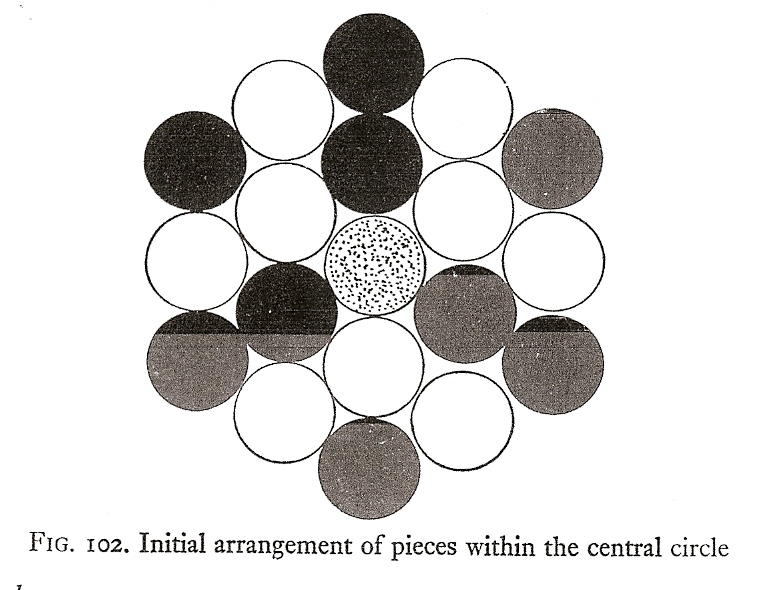
There are many variations in the play of this traditional game - variations which are dependent upon the culture of the players. Winning is dependent upon a player's manual dexterity but some strategy is involved.
The following method of play is an edited version found in R.C. Bell's Board and Table Games from Many Civilizations, Volume II, pages 127-129, Dover Edition, 1979. Since that time various modifications in the play of the game have been made by the International Carom Federation.
A diagram of a Carom board is shown in Figure 101 above.
This popular game is played on a board resembling a small billiard table with four netted pockets at the corners. The entrances to the pockets are 1 1/4 times the diameter of the striker.
The measurements of a Carums (sic) board are given in fig. 101. The board is highly polished, and the coefficient of friction is further reduced by powdered French chalk.
Each player has nine discs of his own colour, and there is one red queen disc. All are 1 inches across and some 3/16 inches in thickness, made of hardwood; and a striker 1 1/3 inches across, of bone or ivory. The discs are arranged within the central circle as shown in fig. 102, and then the opening player (White) places the striker anywhere within the rectangular box on his own side of the board, and flicks it with the middle finger of his right hand at the discs in the centre, trying to knock one of his own discs into a pocket.

1. White plays first, and the turn continues as long as a white disc is pocketed.
2. After each strike the striker is returned to the player's own box.
3. The striker may rebound from the walls and then strike a disc.
4. The striker must cross the front line of the box, but it can be directed at a side wall with spin to cause it to screw back over the line and hit a disc behind the striker's starting point.
5. A player may hit an opposing disc to use it to pocket one of his own.
6. If a player pockets one of his opponent's discs it remains in the pocket, and the turn ceases.
7. Pocketing the red disc promises 5 points, but it must be 'covered' by a player's disc in any pocket, otherwise it is returned to the centre point, together with any of the player's discs pocketed in the same turn of play.
8. If the striker enters a pocket with a disc, the disc is returned to the board and placed anywhere within the central ring by the opponent, and the turn ceases.
9. If the striker enters a pocket, the opponent takes one of the player's discs out of a pocket and places it within the central ring. If the player has not scored he is penalized by a score of minus one point.
10. When a player has pocketed all his discs he scores the number of his opponent's piece still on the board, plus 5 for the queen if she has been pocketed by him. The queen-score only counts for the winner of the setup.
11. There may be several setups to a game; and a match consists if three games, each of 30 points.
There are two methods of scoring with the red queen:
i. The red may be pocketed at any time, but must be covered in the same turn of play with a player's disc in any pocket. (As described in rule 7.)
ii. The red must be pocketed after the player's last disc. This is the more skilful game. On the 4th March, 1956, an All-India Carrom (sic) Federation was formed to control the size and shape of championship boards, and to draw up a code of rules. These are obtainable from the All-India Carrom (sic) Federation, Nehru Stadium, Madras-q.
Last update March 25, 2010